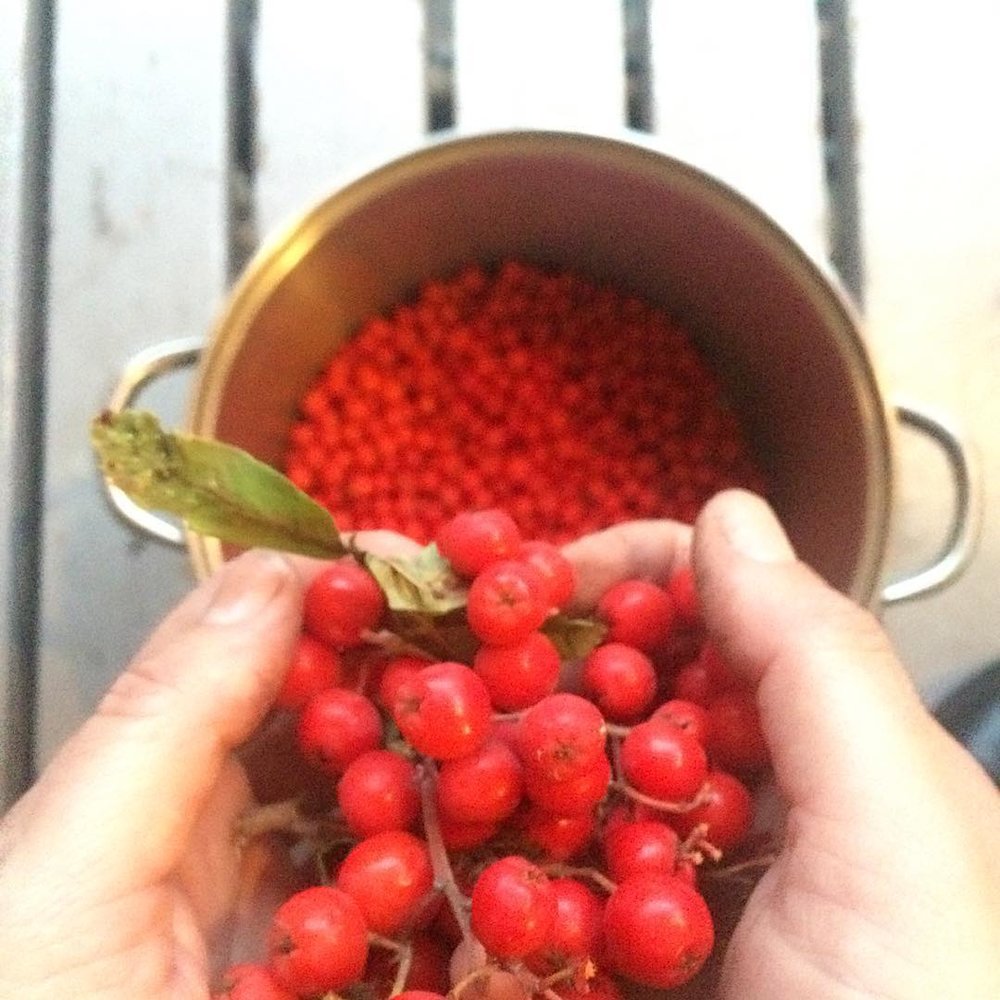Rosemary Rowan Apple Jelly
I love Rowan trees. Everything about them. Groaning with fruit when everything else is going dormant, their bright apple-like "berries" brighten up grey fall days. And so imagine my delight when I first discovered my ancestors made jams, jellies and wines from its fruit. Not everyone "gets" the flavour profile of rowan jelly. It's sweet, but bitter. Perhaps not the preserve for toast (though I adore it), it's spectacular served with hard cheese or with duck, venison and other game meats. I love rowan jelly on thick bread with thin slices of aged gouda. It's also truly wonderful served with a Yule bird of choice. I like to make big batches of rowan apple jelly in October and give jars away as holiday gifts.
A Bit About the Tree
The Rowan is a member of the Rosacea—or rose—family, which is characterized by its pomme fruits. Rowans are native to Europe, including Britain, and the western portions of Asia, and grow across the northern hemisphere. Because of a similarity to the leaves of an ash, it is sometimes called Mountain Ash, though it's not related to true ashes. Here in the Pacific Northwest, we do have a native Rowan called the Sitka Mountain Ash, however the trees you see on boulevards and in yards are usually European Rowans or European Mountain Ash.
The botanical name of the Rowan, aucuparia, comes from the Latin auceps, meaning "a fowler". This refers to the time honoured use of the berries as a lure by bird catchers; indeed, the tree is sometimes known as the Fowlers' Service Tree or Cock-drunks as the fruits were thought to intoxicate birds. Also, wouldn't it be fun to make, label & gift Cock-drunks jelly? Yes. Yes, it would. The genus name Sorbus means ‘stop’, possibly referring to the power of the Rowan to prevent enchantment. More on that later...
Beautiful, plentiful and not even poisonous…
Many North Americans think Rowanberries are poisonous, but folks around the rest of the world have been eating them forever. The lovely scarlet pommes are high in Vitamin C, however they do contain sorbic acid, making them very astringent. Eating them raw can cause stomach upset, but there’s little chance that’s going to happen because they taste horrendous eaten right off the tree. Cooking, freezing or drying renders them safe to consume and they make the most wonderful jellies, syrups and wines. Like other fruits in the Rose family (apples, for example) the seeds and possibly the leaves are known to contain some toxic properties… so, try, try, try to resist eating the not-even-remotely-tasty seeds (you strain them out for rowan jelly). Also, don't touch or eat anything you're not 100% certain of. There are a lot of red berries out there in the fall and not all of them are your friends. Get a good botany book and take a foraging course to eliminate any doubt.
In places with a proper winter, it is advised to wait to gather rowanberries until after the first frost. That can be a little tricky in more temperate climes. Basically, start checking the berries in October. If they’re a deep red colour and they have a bit of give to them when you pinch them, they’re good to go. I also game the system a bit by freezing the berries before I cook with them. Word on the street is that this sweetens them up a bit. I don't know that it matters all that much—I've made rowan jelly with both fresh and frozen and to be honest, it tasted the same to me.
Rowan Lore: Some Magical Tidbits
In folklore, the Rowan was widely venerated as the tree of strongest possible protection over malicious, magical influences. This was true in all parts of the British Isles and Europe where many cultures considered the tree sacred. In Scotland the Rowan was known as the Quicken Tree – the Tree of Life. With its scarlet berries like living drops of blood it was believed to have mighty powers of protection. Charms made from Rowan twigs and bound with red thread were believed to ward off witches and crosses carved from Rowan wood protected babies from wicked fairies. I could go on (and on) about Rowanlore, but I think it deserves it’s own post. Soon!
Recipe: Rosemary Rowan Apple Jelly
A (very) old combination of fall flavours come together in this beautiful, slightly bitter, ruby red jelly.
Makes: Depends on how much fruit you have!
Prep time:
Cook time:
- Equal amounts rowanberries and crabapples or other cooking apple, cut into quarters, cores & all
- Granulated sugar
- Sprigs of fresh rosemary
- 1 lemon
- Water
- Put equal weight of rowanberries and cut apples into a large, heavy-bottomed pot and cover with just enough water.
- Cook gently for 40 minutes or until the fruit is very soft
- Mash the fruit or use a food mill and strain the mixutre through a jelly bag or muslin-lined sieve for several hours—overnight, if you can swing it. Reserve the liquid.
- If you squeeze or press the straining fruit, you'll end up with more liquid for jelly making, but you'll get a cloudy preserve. However, that's between you and your gods.
- Measure the liquid, and put it into a deep clean pot. For every 550mls of liquid add, 450g sugar. Bring to the boil, stirring to dissolve the sugar. Add the juice of one lemon and a couple of sprigs of rosemary.
- Boil until it reaches setting point, remove rosemary and skim off foam.
- Pour into sterilized jars (leaving headroom) and process in a hot water bath for 10 minutes.
- If you’re feeling fancy, place a small sprig of rosemary on top and pour a little jelly over the greenery to seal it in. Rowan jelly can be stored unopened for a year (at least).



